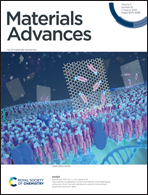Controlled disassembly of azobenzene cellulose-based thin films using visible light†
Abstract
In efforts toward designing self-assembled materials that can later be disassembled easily to avoid destruction of component materials during separation and recycling to minimize waste at their end of life, we report the fabrication of robust, water resistant polymer multilayers whose disassembly could be triggered upon irradiation of wavelengths and intensities of blue visible sunlight. Self-assembled thin films for study were prepared by combining a water-soluble biodegradable polymer, sodium cellulose sulfate (NaCS), and a water-soluble azo dye photo-switch, Bismarck Brown Y (BBY) via layer-by-layer (LbL) assembly. The resultant multi-layered materials (NaCS/BBY) were held together by weak intermolecular interactions between the polymeric sulfate groups and the amino groups of the photo-switch, forming robust and water-resistant materials. The photo-disassembly of the films was assessed using ‘rainfall conditions’ and ‘sunlight’ where it was demonstrated that blue visible light could trigger the successful disassembly of the films at a rate of ka = 7 ± 1 × 10−3 absorbance units per h. Optical pump-probe experiments and confocal Raman spectroscopy supported a mechanism that the disassembly was triggered by the trans-to-cis geometric isomerization of BBY. This method of sunlight- and water-triggered disassembly can in principle allow for recovery of reusable components to be applied as next generation sustainable materials for products and recycling processes.



 Please wait while we load your content...
Please wait while we load your content...